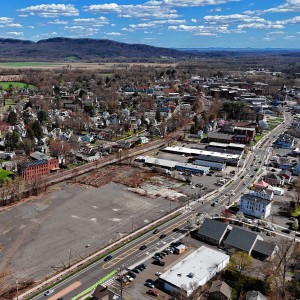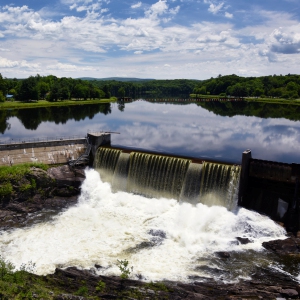Northampton mayor salutes farmers’ ‘determination’
| Published: 07-14-2023 11:35 PM |
NORTHAMPTON — Mayor Gina-Louise Sciarra issued a statement on Friday addressing the impact of the flooding of the Connecticut River in the city, her first since the floods wrecked havoc in Northampton and across the Pioneer Valley earlier in the week.
Sciarra joined Gov. Maura Healey in visiting affected areas in Hampshire County last Wednesday following flooding caused by heavy rainfall along the Connecticut and Mill rivers and in neighboring Vermont.
Later that same day, Sciarra, along with state legislators Jo Comerford and Lindsay Sabadosa, the city’s Department of Public Works Director Donna LaScaleia and Massachusetts Department of Agricultural Resources Commissioner Ashley Randle, visited Grow Foods Northampton to assess the damage and meet with local farmers.
“I have been amazed by the resilience and optimism displayed by the farmers,” Sciarra said in the statement. “Despite the challenges they face, they remain hopeful for the future. Their determination is truly inspiring.”
At Grow Food Northampton, all 10 of the nonprofit’s community farms on the land were impacted, with at least two experiencing total crop loss. Equipment including water pumps and irrigation lines were also badly damaged. Executive director Alisa Klein said that 275 of the organization’s 325 community garden plots had been submerged by the floods.
“We have many people who have community garden plots who are food insecure to begin with,” Klein said. “Now, they won’t be able to harvest those plots.”
Erik Stenfors, a produce safety inspector from the Massachusetts Department of Agricultural Resources, visited Grow Food Northampton on Friday to discuss how to safely dispose of contaminated foods and assess the damage.
Stenfors said most of the produce on Grow Food Northampton’s farms would be unable to be sold, although some may be able to be cured and dried to sell the seeds.
Article continues after...
Yesterday's Most Read Articles
 More than 130 arrested at pro-Palestinian protest at UMass
More than 130 arrested at pro-Palestinian protest at UMass
 Public gets a look at progress on Northampton Resilience Hub
Public gets a look at progress on Northampton Resilience Hub
 Northampton bans auto dealerships near downtown; zone change won’t affect Volvo operation on King Street
Northampton bans auto dealerships near downtown; zone change won’t affect Volvo operation on King Street
 UMass basketball: Bryant forward Daniel Rivera to be Minutemen’s first transfer of the offseason
UMass basketball: Bryant forward Daniel Rivera to be Minutemen’s first transfer of the offseason
 Town manager’s plan shorts Amherst Regional Schools’ budget
Town manager’s plan shorts Amherst Regional Schools’ budget
 Police respond to alcohol-fueled incidents in Amherst
Police respond to alcohol-fueled incidents in Amherst
“If there’s any floodwater on it, then they can’t sell or consume it,” he said. “They’re going to have to replant.”
The farm also intends to meet with key community partners and farm managers on Monday to address the effects from the flood and continue working with volunteers to help clean up the plots.
Klein said she was grateful for the assistance from the MDAR, and hoped to secure further relief from both the state and federal emergency management agencies.
“The state is paying attention,” she said.
Sabadosa said that the extent of the damage was still being assessed from the flooding, but that she expected it to meet the $12 million threshold to be declared a disaster area by the Massachusetts Emergency Management Agency (MEMA).
“We’re not a federal disaster site like Vermont, but the farmers have been hit particularly hard,” she said. “We’re going to step up in the greatest way we can.”
Data from the U.S. Geological Survey shows at 1:15 p.m. on July 10, the Mill River in Northampton reached a discharge of 5,680 cubic feet per second and a height of 15 feet. The USGS monitoring station of the Connecticut River in Montague showed a maximum height of 32 feet and a discharge of 10,300 cubic feet per second the following day.
A separate release put out by Northampton’s health commissioner Meredith O’Leary advised avoiding all recreational use of local waterways and beaches along the Connecticut and Mill rivers — including swimming, boating, and fishing — until the waters subside. The release noted that water samples from Musante Beach in Leeds showed high levels of E.coli.
“Swimming or ingestion of contaminated water could result in symptoms like nausea, diarrhea, stomach cramps, chills or fever,” O’Leary said in the release. “If you are concerned about your potential exposure to contaminated water, please contact your health care provider.”

 Valley lawmakers seek shorter license for FirstLight hydropower projects
Valley lawmakers seek shorter license for FirstLight hydropower projects State Senate budget funds free community college for all
State Senate budget funds free community college for all ‘We can just be who we are’: Thousands show support for LGBTQ community at Hampshire Pride
‘We can just be who we are’: Thousands show support for LGBTQ community at Hampshire Pride Doors open at Tilton Library’s temporary home at South Deerfield Congregational Church
Doors open at Tilton Library’s temporary home at South Deerfield Congregational Church
